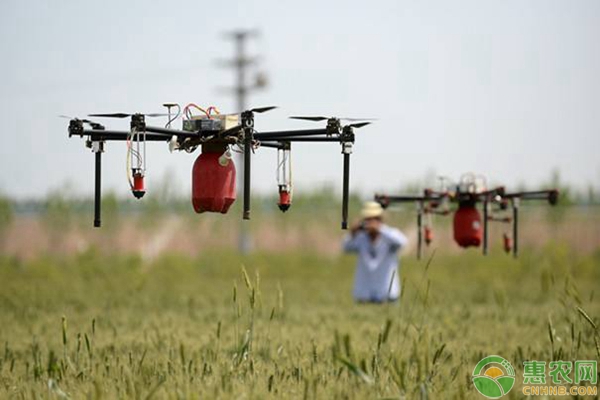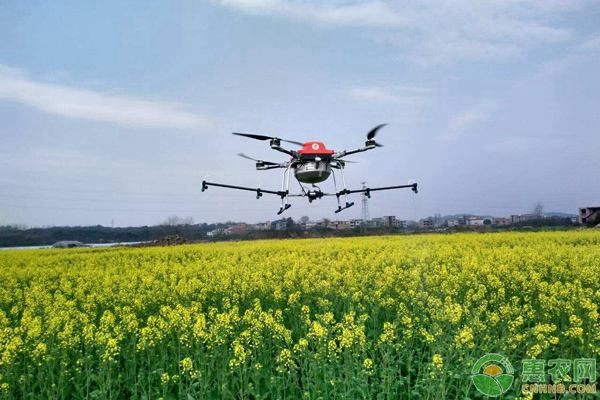At present, drones are slowly gaining popularity in many areas of China. What are the advantages of drones? Which method of rice drone and artificial spraying is effective? The following small series brings you an experimental case, only for reference!

1 Materials and methods
1.1 instruments and medicaments used
1.1.1 Instruments
Multi-rotor remote control drone (hereinafter referred to as UAV), using centrifugal rotary nozzle; 3WBD-16C knapsack electric sprayer (hereinafter referred to as artificial spray), using hydraulic tangential liquid inlet double nozzle.
1.1.2 Pharmacy used
It is used to control rice planthopper, rice leaf roller and rice sheath blight, mainly including spring thiazole zinc suspension (concentration 40%), thiamethoxam water dispersion granule (concentration 25%), indoxacarb suspension (concentration 30%), cyanide-toxic suspension (concentration 36%).
1.2 test and demonstration settings
In the suitable period of rice pest control, the plant protection and quarantine station of Xishuangbanna Dai Autonomous Prefecture applied the drone and electric sprayer to conduct a comparative experiment on the application of 10 groups of rice fields in the Xishuangbanna Dai Autonomous Prefecture Agricultural Demonstration Base. The test area is a regular rectangle with an area of ​​about 0.8 hm2. There are no buildings and no pole wires around, which provides favorable conditions for the drone application. In this experiment, a total of 3 plots were set up, and isolation zones were set up between the plots, of which 6 670 m2 was applied by drone, 667 m2 was applied by artificial spray, and 667 m2 was applied by blank control (no application was applied).
The pest control demonstration test unified time and medicament, and unified operation, is carried out by the agricultural professional cooperatives. The trial is scheduled to be applied on July 7, 2017, and all pesticide administrations will be completed by July 10. The test is mainly for the control of rice planthopper, rice leaf roller and rice blight, so the formula is 16 g thiamethoxam water dispersible granules and 120 mL cyanide-toxic suspension agent, and can also use spring thunder. · Thiazole zinc suspending agent and indoxacarb suspension, the dosage is 40 mL and 120 mL, respectively.
1.3 Test methods
1.3.1 UAV application This test uses a multi-axis UAV with a no-load standard mass of 23 kg, a payload of 10 kg, a rotor diameter of 860 mm, a fuselage width of 1 070 mm, and four applications. The medicine nozzle has a flying speed of up to 8.00 m/s, a cruising speed of 4.80 m/s, a continuous flight of about 20 minutes, a spraying range of 6 to 8 m, a maximum operating radius of 200 m, and a height of about 200 m when applied. 4 m, 667 m2 requires about 1 kg of water and is supplied by the battery.
1.3.2 The equipment used for artificial spray is 3WBD-16C knapsack electric sprayer with double fan nozzle. The spray speed of the nozzle is about 1 L/min. When spraying, the person keeps the walking speed of 0.65 m/s. It takes 480 L/hm2. .

1.4 Control methods for prevention and treatment
1.4.1 Rice locust control effect survey The population of rice planthoppers was surveyed in the field before application and 5, 10, 15 days after application, and 20 plexes were randomly selected by parallel multi-point hopping sampling method, and shaking or tapping was taken. The method of rice plexus calculates the number of planthoppers among the rice groves, and does not distinguish the species and age of the rice planthoppers, so as to obtain the effect of prevention and control.
1.4.2 The investigation on the control effect of the rice leaf roller was carried out on the 5th, 10th and 15th day after the application, and the rice leaf roller was tested in the field. According to the principle of randomness, the rice plexus was selected by parallel jump sampling method. At each point, 2 cultivars of rice were taken, and the total number of leaves and the number of leaves were calculated, and the leaf was brought back to the laboratory to calculate the number of live insects in the leaf.
1.4.3 Rice sheath blight control effect investigation 10 days after the completion of the application, the rice sheath blight disease control investigation was carried out in the field, and the rice sheath and leaf disease conditions were graded according to the rice plant, and the plant was the basic unit. Five points were taken for each diagonal line, and five clusters were surveyed at each point. A total of 15 samples were recorded, and the total number of plants and the number of diseased plants were recorded, and the disease incidence grades of the diseased plants were marked. The classification of the diseased grades of the diseased plants was carried out according to the following criteria: the whole plant was healthy and disease-free, with a grade of 0; the fourth leaf and the following leaf sheaths and leaves were all diseased, with grade 1; the third leaf and its leaf sheaths and leaves were both The incidence was grade 3; the leaf sheath and leaf of the second leaf were infected with grade 5; the whole leaf sheath and leaf were all infected with grade 7; the whole plant died of rice blight and was grade 9.
2 Results and analysis
2.1 Application safety investigation and analysis After the application, the growth of rice plants was observed in the field at 5, 10 and 15 days, respectively. No abnormalities or abnormalities occurred, and the growth of rice plants was normal, indicating that the planting drones were used for ultra-low altitude. Concentrated spraying of high-concentration pesticides does not adversely affect the normal growth of rice.
2.2 Rice pest control effect 5d after prevention, through the application area
The investigation on the control of rice pests and diseases was carried out. The results showed that the control effect of rice planthopper in the drone application area was 100.00%, while the control effect of rice planthopper in the artificial spray area was 93.90%. At the same time, the control effect of the rice leaf roller is about 86.00% in the drone application area, and the rice leaf roller control effect in the artificial spray area is about 90.20%. It can be seen that the control effect of UAV application on rice planthopper is better than that of artificial spray at this time, but in the control process of rice leaf roller, the insecticidal effect is slightly worse than artificial spray.
After 10 days of treatment, it was found through field investigation that the control effect of rice planthopper in the drone application area was about 98.70%, and the average control effect of rice planthopper in the artificial spray application area was about 94.80%. At the same time, the control effect of rice leaf roller in the drone test area was 88.60%, and the control effect in the artificial spray application area was 87.90%. It can be seen that after 10 days of control, there is no significant difference in the control effect of drone application and artificial spray on rice leaf roller.
After 15 days of treatment, it was found that the effect of drone spraying against rice planthopper was 97.20%, which was 5.30% higher than that of artificial spraying. The difference between the two was not obvious, and it had very good control effect on rice planthopper. In the spray application area of ​​drone, the control effect of rice leaf roller is about 87.33%, which is 1.56% higher than that of artificial spray. The control effect is similar under the two application modes, and it can effectively control the rice leaf roller The hazards of rice.
After 15 days of treatment, the hazards of rice sheath blight were basically stereotyped. Through field investigation and control, it was found that the average control effect of rice sheath blight in the UAV test treatment area was 92.40%, while the average control effect of rice sheath blight in the artificial spray test area was observed. For 85.80%, the control effect of the drone is more obvious.

Combined analysis found that although drone application and artificial spray application were almost equivalent in the control of rice leaf roller, from the control effect of rice planthopper and rice sheath blight, drone spray application The effect is more obvious, so the drone control effect on rice pests and diseases is better than that of electric sprayers, and there is no obvious phytotoxicity.
3 Conclusion
The test time and the formulation of the drug used in this test were consistent, and the formulation of the drug used was also consistent. The plant protection drone used ultra-low altitude, high concentration and low volume spray, while the knapsack electric sprayer used large-volume artificial spray. The control targets are rice planthopper, rice leaf roller and rice sheath blight. Field investigation and analysis were conducted on the 5th, 10th, and 15th day after treatment. The results showed that the ultra-low altitude and high concentration spray method did not cause damage to rice growth safety, and the overall control effect was significant compared to artificial spray. The way is better.
The application of plant protection drones not only has high spraying efficiency, but also can effectively reduce the work intensity of personnel. More importantly, it can ensure crop safety, effectively solve the problem of difficult pest control in the middle and late stages of rice, and reduce the loss of farmers. As for the specific application of UAV application in the future, the following suggestions are proposed: rice planting areas controlled by drones should be selected as much as possible in areas where planting areas are contiguous, basic conditions are perfect, and management is consistent, which is convenient for drone operations. Can greatly improve the control effect. It can be said that the prevention and control of drones will be the main method for the prevention and control of crop pests and diseases in the future. It is also necessary to vigorously carry out various types of experiments and demonstrations, accumulate valuable experience in practice, and gradually promote them in other crops.
Accessories,Curing Light Meter,Dental Curing Light Meter,Economic Dental Curing Light Meter
Rolence Enterprise Inc. , https://www.rolencedent.com